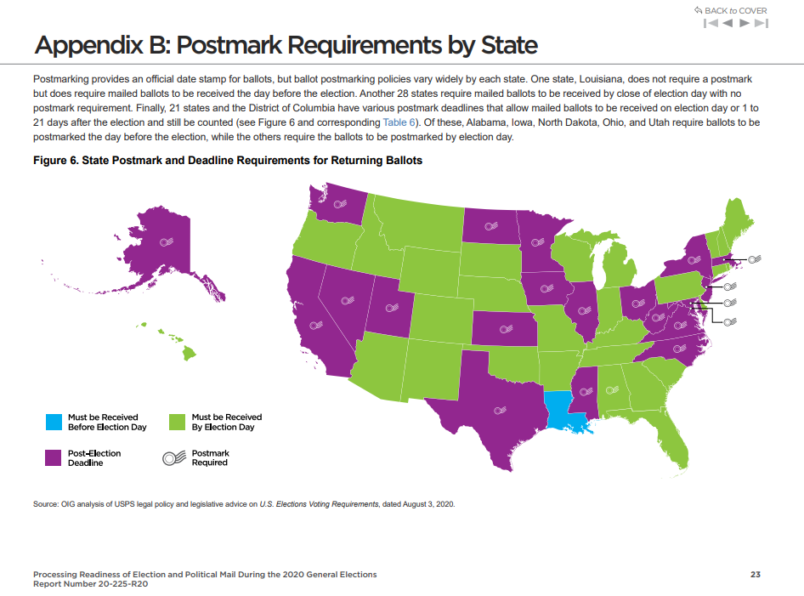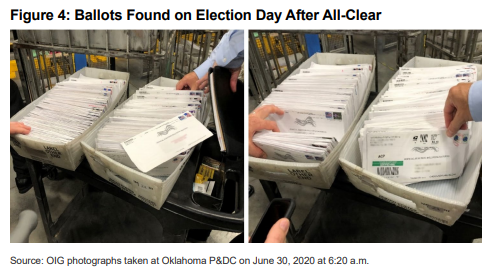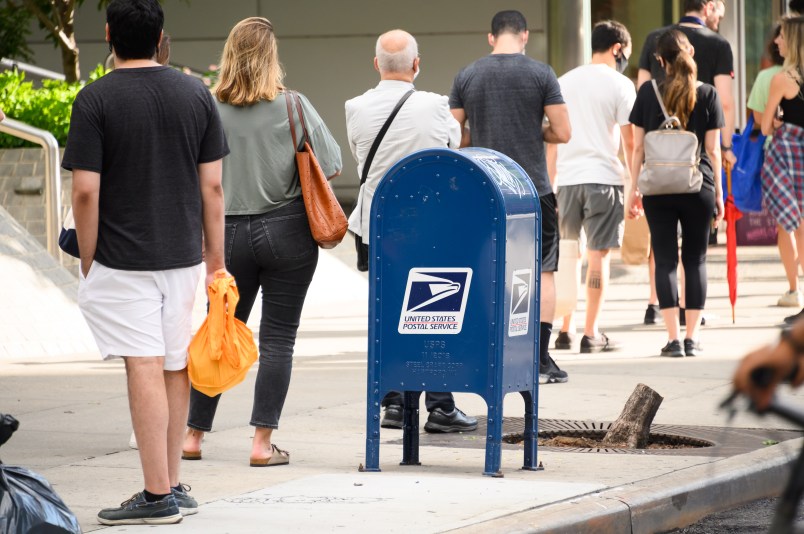The Postal Service’s internal watchdog found an decrease in on-time delivery of election and political mail in a review earlier this year, the results of which were published Tuesday, underlining fears that a sharp uptick in mail-in voting may end up disenfranchising some voters this November.
The review from the USPS inspector general took place in May and June this year. Importantly, that was before the new postmaster general, Louis DeJoy, instituted a series of changes that resulted in mail slowdowns across the country. And many of the inspector general’s findings don’t concern Postal Service employees themselves, but rather their counterparts in state and local government.
Still, with a record number of Americans expected to use the mail to vote this year, the report identified key weaknesses that could impact the vote tally.
“Since our prior audits, the Postal Service has improved internal communication between headquarters and mail processing facilities, and developed online Election and Political Mail training,” the report found. “However, the amount of identifiable Election and Political Mail delivered on-time nationwide was 94.5 percent from April 2020 through June 2020, a decrease of 1.7 percentage points compared to the same time period in 2018.”
The inspector general also highlighted a point that the USPS general counsel flagged to 46 states and the District of Columbia earlier this summer: Local deadlines for requesting and casting ballots are often set close to Election Day, meaning that some voters who request or submit ballots at the “last minute” may actually be out of luck.
The inspector general’s report, citing numbers from USPS management, highlighted a few significant shortcomings from state election officials: In 11 states, for example, over 44,000 ballots were sent from election boards to voters “the day of or day before the state’s primary election.” In Pennsylvania, 500 ballots were sent to voters the day after the election.
The state-by-state patchwork of election laws, especially concerning something like postmarking requirements, makes national election mail policy a difficult balance:

New York voters realized this might be a problem in primary season, when postmarking errors imperiled thousands of ballots.
“Without a postmark on return ballots mailed by voters, a ballot could be rejected and a vote not counted,” the report read.
In recent congressional testimony, DeJoy was short on details about a plan to ensure the prompt delivery of election mail, but he did reiterate to lawmakers that it was USPS policy to postmark all ballots, and that the USPS would seek to expedite all election mail, not just first-class mail.
But, frustrated with DeJoy’s refusal to hand over certain documents related to changes in the USPS policy toward late mail delivery trips, decommissioned sorting machines and other issues, the House Oversight Committee on Monday announced its intent to subpoena him.
The IG report also identified several pitfalls that, experts have told TPM, could especially impact states where postal and election workers have less experience with high vote-by-mail volumes, such as instances of election and political mail getting left behind at USPS facilities.
Over the two-month review of processing and distribution centers (P&DC) in seven cities, the report found, “we identified approximately 200 ballots at the Oklahoma City P&DC and 68,000 Political Mail mailpieces at the Baltimore P&DC that had not been processed.” (The ballots in Oklahoma were successfully delivered after investigators noticed them, the report assured readers.)

And none of the seven facilities used the Postal Service’s “Operational Clean Sweep Search Checklist,” the review found, referring to the list of specific facility areas to check to ensure that election and political mail isn’t lost in the system.
In large part, USPS management acknowledged the shortcomings identified in the report. But it disagreed with the inspector general’s recommendation “to work toward creating a separate, simplified mail product exclusively for Election Mail that would support uniform mail processing, including mandatory mailpiece tracking and proper mailpiece design.” There simply is not enough time to do so before the 2020 elections, USPS management said in an included response to the report.
However, the agency’s management responded, the Postal Service will undertake “herculean efforts” to ensure that ballots meet state deadlines.







Hard to do that if USPS is being sabotaged by Postmaster DeJoy and his newly appointed cronies! After all, DeJoy is poised to profit with the downfall of the USPS, not to mention his Orange Master can cheat his way to re-election!
Next up, thousands of voters complain that their postmarks on November 2, 2020 read “November 4, 2020”…
IF YOU MAIL YOUR VOTE, CHECK THE POSTMARK. DO IT FROM THE POST OFFICE AND DO NOT LET THEM TAKE IT, POSTMARK IT AND THROW IT IN THE PILE WITHOUT YOU ASKING TO SEE THE MARK THEY PUT ON IT.
Me (MI)…I’m putting mine in the drop box early in front of the building where the city clerk and his office will take it directly in to be counted on election day. Fuck DeJoy. If he ends up in prison garb it’ll still be too good for him when all this is over. Someone should tell these fuckers that they will be deemed criminals when all is said and done. Donnie Dumbshit won’t be able to help them then.
Since I’m 65, I’m eligible to vote by mail. I live in a San Antonio, Texas and don’t trust the mail in process. I decided to vote during the early voting period. I’d rather mask up and stand 6ft apart than risk the known mail failures in my city.
I thought I would provide an excerpt here from a Wisconsin government website that details a few things about Absentee ballots. Everyone should be able to find equivalent information for their own states.
https://elections.wi.gov/node/7039
It is my intention to fill out my ballot shortly after receiving it, take my completed ballot down to my city clerk, call the clerk’s office, wait for the clerk (or designee) to come outside, place the ballot in a mutually observable location while maintaining social distance, back away and observe the clerk (or designee) pick up the ballot, and observe the clerk (or designee) re-enter their office building. You might want to consider a similar tactic if possible. As much as I like the USPS, I don’t trust Trump’s cronies because they’re doing their best to fuck up the works, so I’m not relying on the US Snail.